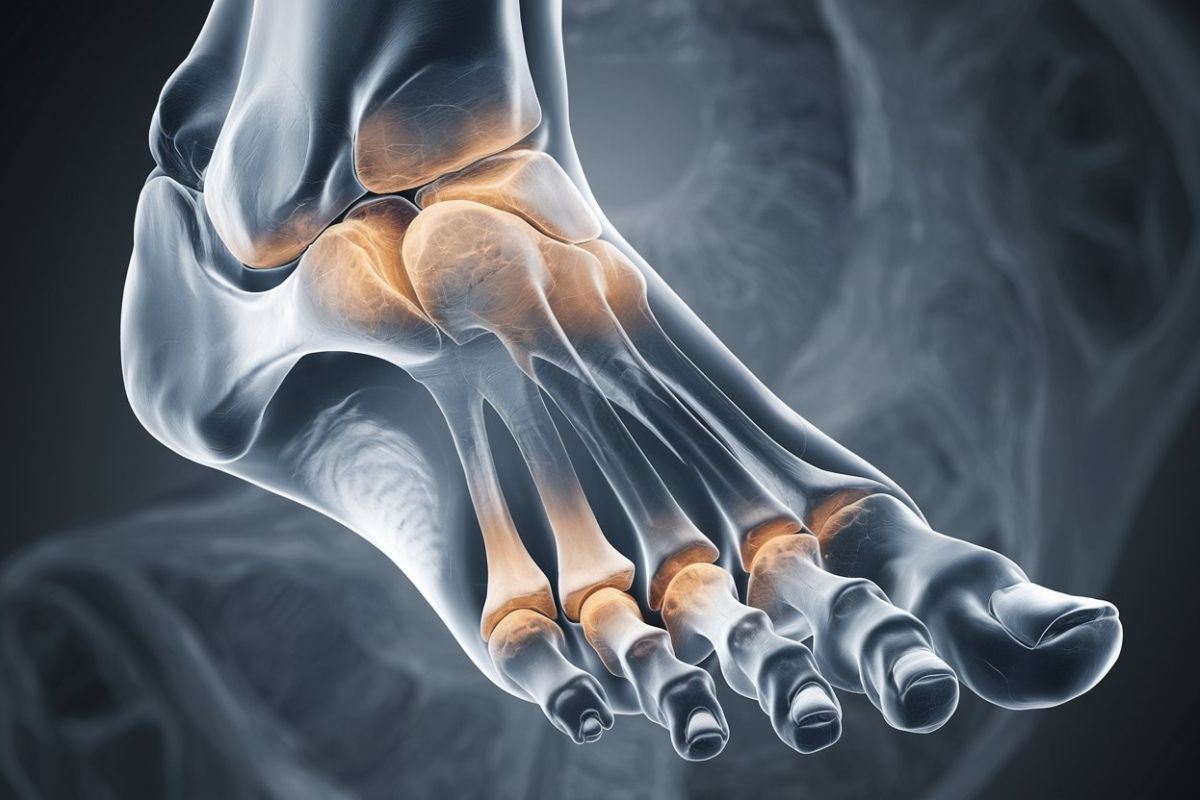
What is Carpotarsal Osteochondromatosis? Carpotarsal osteochondromatosis is a rare bone disorder marked by abnormal bone growth and the formation of osteochondromas, particularly in the wrists and tibiotalar joints. This condition often leads to joint pain, swelling, and limited mobility, usually appearing in the first or second decade of life. Diagnosis involves imaging techniques like X-rays, CT scans, and MRIs to visualize the abnormal bone growth. Treatment typically requires surgical removal of the osteochondromas to alleviate symptoms and restore joint function. Understanding this condition is crucial for effective management and improving the quality of life for those affected.
Key Takeaways:
- Carpotarsal osteochondromatosis is a rare bone disorder causing joint pain and abnormal bone growth. Surgery is often needed for treatment, and regular monitoring is crucial for recovery and potential recurrence.
- Understanding the genetic aspects and related conditions of carpotarsal osteochondromatosis can provide insights into its diagnosis and treatment. Further research is needed to improve patient outcomes.
What is Carpotarsal Osteochondromatosis?
Carpotarsal osteochondromatosis is a rare bone disorder that affects the wrists and tibiotalar joints. It's characterized by abnormal bone growth and the formation of osteochondromas. Let's dive into some key facts about this condition.
-
Definition: Carpotarsal osteochondromatosis involves abnormal bone proliferation and osteochondromas in the upper limbs, especially the wrists and tibiotalar joints.
-
Prevalence: This condition is extremely rare, with few documented cases. Its exact prevalence remains unclear due to limited research.
-
Symptoms: Symptoms often include joint pain, swelling, and limited mobility. Bony masses and limb shortening may also occur, typically in the first or second decade of life.
-
Diagnosis: Diagnosis usually involves radiographic imaging like X-rays or CT scans to visualize abnormal bone growth. MRI can also assess the extent and complications.
Treatment and Management
Managing carpotarsal osteochondromatosis often requires surgical intervention. Here are some key points about treatment options and recovery.
-
Treatment: Treatment generally focuses on surgically removing osteochondromas to alleviate symptoms and restore joint function. The approach varies based on the size and location of the growths.
-
Surgical Intervention: Surgical methods can range from arthroscopic surgery to open procedures, depending on the complexity of the case.
-
Recovery: Recovery depends on the extent of surgery and the joint involved. Recurrence of the condition can happen in about 20% of cases.
-
Monitoring: Regular follow-up visits are crucial to monitor for recurrence or the development of osteoarthritis, especially after surgical intervention.
Genetic Aspects and Related Conditions
Understanding the genetic background and related conditions can provide insights into carpotarsal osteochondromatosis.
-
Genetic Aspects: While not typically linked to a specific genetic mutation, carpotarsal osteochondromatosis is part of a broader spectrum of bone dysplasias with potential genetic underpinnings.
-
Hereditary Multiple Exostoses (HME): HME is a related condition characterized by multiple osteochondromas throughout the skeleton, inherited in an autosomal dominant manner.
-
EXT1 and EXT2 Genes: HME is associated with mutations in the EXT1 and EXT2 genes, which are responsible for synthesizing heparan sulfate proteoglycans.
Osteochondromas and Their Impact
Osteochondromas are a key feature of carpotarsal osteochondromatosis. Let's explore their characteristics and impact on the body.
-
Osteochondromas: These are cartilage-covered bony growths that can be solitary or multiple, often arising spontaneously or after osseous trauma.
-
Solitary vs. Multiple Osteochondromas: Most osteochondromas are solitary nonhereditary lesions, while 15% occur as multiple lesions associated with HME.
-
Common Sites of Origin: The metaphysis of long tubular bones is the most common site for osteochondromas, frequently affecting the distal femur, proximal humerus, tibia, and fibula.
-
Small Bones Involvement: The small bones of the hands and feet are affected in about 10% of patients, while the innominate bone is involved in 5%.
-
Spine Involvement: Although rare, spine involvement can lead to significant complications like cord compression, causing neurological symptoms.
-
Pelvis Involvement: Osteochondromas in the pelvis are typically large and may displace adjacent structures, leading to complications.
-
Scapula Involvement: Affecting 1% of patients, osteochondromas in the scapula can cause shoulder pain and limited mobility.
-
Subungual Osteochondroma: Rare but painful, subungual osteochondromas can cause nail deformity due to growth under the nail.
-
Sesamoid Bone Involvement: Extremely rare, osteochondromas of the sesamoid bone in the hallux can cause foot pain and limited mobility.
Radiographic and Clinical Presentation
Radiographic imaging and clinical evaluation are crucial for diagnosing and understanding carpotarsal osteochondromatosis.
-
Radiographic Appearance: Imaging typically shows abnormal bone proliferation and osteochondromas, with the metaphysis of the affected bone often widened.
-
Clinical Presentation: Patients usually present with painless skeletal swelling or a slowly growing mass, along with joint pain, swelling, and limited mobility.
-
Complications: Complications can include limb shortening, joint deformity, and neurological symptoms if the spine is involved. Recurrence after surgery is also possible.
Historical Context and Diagnostic Challenges
Understanding the historical context and diagnostic challenges can provide a deeper insight into carpotarsal osteochondromatosis.
-
Family History: The condition can occur in families, although not typically linked to a specific genetic mutation. The first family description was published by Boyer in 1814.
-
Historical Context: John Hunter first commented on HME in his 1786 lectures, highlighting the long-standing interest in bone dysplasias.
-
Diagnostic Challenges: Diagnosing this rare condition can be challenging due to nonspecific symptoms. A combination of radiographic imaging and clinical evaluation is often necessary.
Differential Diagnosis and Comparison
Differentiating carpotarsal osteochondromatosis from other conditions is essential for accurate diagnosis and treatment.
-
Differential Diagnosis: Other bone dysplasias and conditions causing abnormal bone proliferation, like synovial chondromatosis, must be considered.
-
Synovial Chondromatosis Comparison: This disorder involves cartilage nodules within the joint capsule, typically affecting people in their fifties and presenting with joint pain, swelling, and decreased range of motion.
-
Treatment Comparison: Both conditions require surgical intervention, but the approach differs. Carpotarsal osteochondromatosis often involves removing osteochondromas, while synovial chondromatosis involves removing floating cartilage pieces and the joint synovium.
Future Research Directions
Further research is needed to understand the genetic and molecular mechanisms underlying carpotarsal osteochondromatosis.
- Future Research Directions: Advancements in understanding the genetic and molecular basis of this condition could lead to better diagnostic tools and treatment strategies, improving patient outcomes.
Final Thoughts on Carpotarsal Osteochondromatosis
Carpotarsal osteochondromatosis, a rare bone disorder, involves abnormal bone growth and osteochondromas in wrists and tibiotalar joints. Symptoms like joint pain, swelling, and limited mobility can significantly impact daily life. Diagnosis often requires X-rays, CT scans, or MRIs to identify abnormal bone proliferation. Treatment usually involves surgery to remove osteochondromas and restore joint function. Regular follow-ups are crucial to monitor for recurrence or complications. Genetic counseling is recommended for families with a history of hereditary multiple exostoses (HME). Understanding this condition's complexities helps in managing it effectively. Further research into its genetic and molecular mechanisms could lead to better diagnostic tools and treatments. Awareness and early intervention can improve outcomes for those affected by this challenging disorder.
Frequently Asked Questions
Was this page helpful?
Our commitment to delivering trustworthy and engaging content is at the heart of what we do. Each fact on our site is contributed by real users like you, bringing a wealth of diverse insights and information. To ensure the highest standards of accuracy and reliability, our dedicated editors meticulously review each submission. This process guarantees that the facts we share are not only fascinating but also credible. Trust in our commitment to quality and authenticity as you explore and learn with us.

